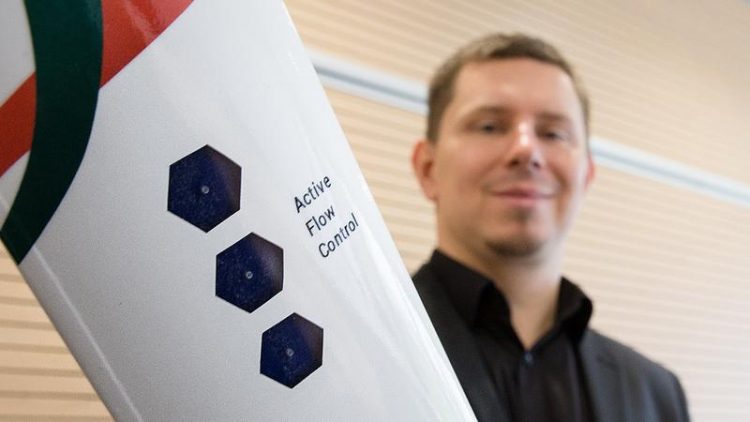Flying: Efficiency thanks to Lightweight Air Nozzles

Integrated actuators for active flow control in the demonstrative rotor blade. Vivek Bakul Maru
Active flow control has nothing to do with flowing rivers and the dead wake is actually air, and not really dead at all. Basically speaking: “We investigate ways of influencing aerodynamic flows of aeroplanes, cars or wind turbines”, explains Dipl.-Ing. Martin Schüller, research fellow at the Fraunhofer Institute for Electronic Nano Systems in Chemnitz.
“To this end, we use actuators. It helps to imagine small loudspeakers pumping air with a very high velocity.” These so-called actuators can actively control the aerodynamic flow through targeted air blasts. The Federal Cluster of Excellence MERGE at Chemnitz University is contributing significantly to this research project.
Optimising their application and design for varying uses is the subject of Schüller’s PhD thesis and of his daily work along with his colleagues Mathias Lipowski, Perez Weigel and André Gratias in the “Flow Control Actuators and Systems“-team. So far the usual approach has been trial and error”, Schüller says and adds: “I wanted to develop an optimisation tool that allows for a simulation of as many application parameters as possible.”
The result is a combination of a closed analytical model with a network model, which can calculate all elements analytically for the first time. With this tool the actuators’ performance can be improved for every application.
Schüllers PhD thesis takes a closer look at an application in aviation. Actuators can be integrated into wings or fins e.g. improving the climb and thereby helping to save on fuel. Nevertheless, this integration requires additional assembly work and creates more weight leading to higher fuel consumption, as the scientist explains.
Which is why, Schüller and his team have investigated the integration of actuators into several material compounds and components within the Federal Cluster of Excellence MERGE. They took some inspiration from automotive engineering in this respect. “We try to fight the so called dead wake at the car rear, where turbulences emerge, slowing down the car. Actuators at the rear can counteract this effect”, Schüller explains.
The most important parameters are taken from lightweight design: There are only a few production technologies and materials that are suitable for an especially low weight, the installation space is pre-defined, as are the aerodynamics of the vehicle. According to the chosen technology a variety of actuator designs is possible, because their layout is predetermined technologically.
Milling, 3D printing, injection moulding and stereo lithography allow only for specific forms of the nozzle and cavity. Innovative fibre-reinforced plastic materials, which are the main focus of MERGE, possess other properties that have to be taken into account for the integration of the actuators.
Interdisciplinarity Ensures Practical Strengths and Economic Efficiency
Mechanical and electrical engineers within the Cluster cooperate with the Faculty of Economics and Business Administration at Chemnitz University of Technology on an interdisciplinary level. Professor Uwe Götze, Professor of Management Accounting and Controlling, and his colleagues investigate the economic efficiency of each of the manufacturing technologies as well as the life cycle of the actuators.
For example, for the aircraft wing. The economists analyse whether the saving in fuel during the launch can make up for the higher fuel consumption during the flight, i.e. whether the use of actuators would be sensible from an economic point of view.
All these parameters – from the manufacturing technology via aerodynamic values up to economic efficiency – are combined in MERGE. Schüller’s optimisation tool can help combine them analytically and create an almost optimal design of the actuators for each respective case.
“We also aim at integrating an adapted actuator system into the rear spoiler of our Chemnitz Car Concept”, Schüller explains. “This is an absolute innovation. Until today there have been studies on actuators in side-view mirrors only, but no implementation has yet been tried for the rear.”
About the Chemnitz Car Concept
Various research areas are merged in the system demonstrator called “Chemnitz Car Concept” (CCC). The “MERGE up!” provided by Volkswagen, serves as a platform for tests and demonstration of the latest research results in cooperation with the Department of Advanced Powertrains. The lightweight vehicle represents the MERGE technologies integrated into an electrically driven car. It will include exemplary parts in the interior and exterior – from lightweight components up to the power train – especially developed and built into the “MERGE up!”.
For more information please contact the project coordinator Martin Schüller, Phone 0371 45001-242, e-mail martin.schueller@enas.fraunhofer.de
For more information on the Chemnitz Car concept please visit https://www.tu-chemnitz.de/MERGE/ccc.php
Media Contact
More Information:
http://www.tu-chemnitz.de/All latest news from the category: Materials Sciences
Materials management deals with the research, development, manufacturing and processing of raw and industrial materials. Key aspects here are biological and medical issues, which play an increasingly important role in this field.
innovations-report offers in-depth articles related to the development and application of materials and the structure and properties of new materials.
Newest articles

“Nanostitches” enable lighter and tougher composite materials
In research that may lead to next-generation airplanes and spacecraft, MIT engineers used carbon nanotubes to prevent cracking in multilayered composites. To save on fuel and reduce aircraft emissions, engineers…

Trash to treasure
Researchers turn metal waste into catalyst for hydrogen. Scientists have found a way to transform metal waste into a highly efficient catalyst to make hydrogen from water, a discovery that…

Real-time detection of infectious disease viruses
… by searching for molecular fingerprinting. A research team consisting of Professor Kyoung-Duck Park and Taeyoung Moon and Huitae Joo, PhD candidates, from the Department of Physics at Pohang University…





















